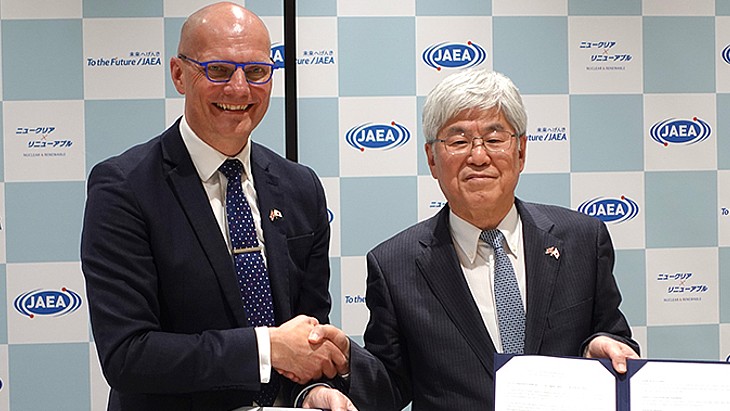
The coated particle fuel (CPF) - which is extra robust because each kernel of uranium is coated in four protective layers - is already being produced by the National Nuclear Laboratory (NNL) at its laboratory in Preston, in northwest England. But the aim of the collaboration is to learn from the experience in Japan where the fuel has been manufactured for use in the High Temperature Engineering Test Reactor.
The collaboration memorandum was signed by JAEA President Koguchi Masanori and NNL CEO Paul Howarth. It focuses on the development of fuel manufacturing technology for an HTGR demonstration reactor and licence arrangements defining the intellectual property rights, with JAEA saying it will "collaborate with NNL to establish HTGR fuel manufacturing technology, utilising the unrivalled experience from Japan, to establish a manufacturing route for fuel for HTGR demonstration reactors in both the UK and Japan".
Emma Vernon, NNL's vice president for Government and New Build, said: "This agreement will further strengthen the relationship between the two laboratories and demonstrates the importance of international collaboration to innovate together to progress advanced nuclear technologies. The collaboration will bring together the skills that JAEA have developed in coated particle fuel over decades, along with the world class facilities that we have developed here in the UK to deliver sovereign fuel. This is critical technology to enable the UK to achieve net zero."
In December 2022, the UK government announced funding of GBP60 million (USD75 million) for research into HTGRs, a type of advanced modular reactor (AMR), aimed at helping to get a demonstration project up and running by the end of the decade.
Phase A of the AMR R&D programme led to six successful bidders for pre-FEED (front end engineering design) studies for reactor demonstration and fuel demonstration. Phase B is described as "an open, competition-based programme designed to produce up to two HTGR FEED mature enough to enter regulatory review, carry out associated research and development activities, and produce robust delivery plans for a potential Phase C". Phase B will conclude in February 2025. Phase C will see the licensing, construction and operation of an HTGR in the early 2030s.
In July last year, the UK Department for Energy Security and Net Zero announced that a team comprising NNL and JAEA was selected as one of the project entities to implement the Phase B reactor project. They received funding of GBP31 million. In parallel, the department also announced that Phase B would also push the development of an advanced fuel required for AMRs, through the Coated Particle Fuel - Step 1 Programme. NNL, working with JAEA, has been selected by the department to deliver this fuels programme which will build expertise, knowledge and collaboration on coated particle fuel fabrication and scale-up activities.
JAEA and NNL have been cooperating for more than two decades on areas including the nuclear fuel cycle and radioactive waste management as well as advanced reactors. The latest agreement follows a memorandum of cooperation in the field of HTGRs and a memorandum for collaboration on the next stage of the UK HTGR Demonstration Reactor programme, signed in September 2023.
The governments of the UK and Japan expect HTGRs to contribute to decarbonisation through the supply of hydrogen and high-temperature steam to the processing, steelmaking and chemical industries, considered difficult to decarbonise, to achieve carbon neutrality by 2050. JAEA is collaborating with NNL to demonstrate Japanese HTGR technology outside of Japan and to promote its "social implementation" with the aim of returning the decarbonisation technology to Japan.